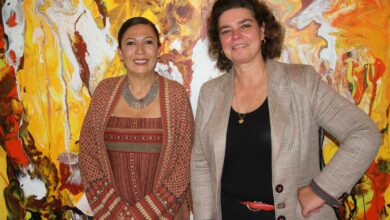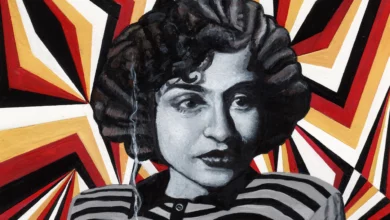An exhibition called “Gamal Abdel Nasser … The Dream” opened to much excitement on Sunday night at the Picasso Gallery in Zamalek, where it will remain for a month.
Pre-opening, it was marketed as a depiction of the 1952 revolution through the eyes of artists from the era, an attempt to add perspective to the ongoing upheavals of 2011. Upon arrival, however, viewers found a very confusing situation.
There is very little artwork from the 1952 revolution or about Egyptians at the time. Aside from a couple of idiosyncratically interesting pieces, the exhibition feels like a brownnosing stunt for the Nasser brand and has very little to do with the “dream,” per se.
The walls are lined with elaborate, albeit nicely produced, paintings of Nasser striking different poses – at times serious, at others relaxed and leaning back, with a number of close-ups – which connect the various portrait sculptures produced in his honor. Additionally, there are numerous paintings with crowds staring at Nasser in star-struck adoration, and a large piece showing world leaders circa 1960 bedazzled as he addresses the UN General Assembly.
Ultimately there’s very little representation of the zeitgeist of the times, aside from how great Nasser was.
What these pictures do however remind us of is those of Hosni Mubarak striking various self-important poses that used to be generously scattered throughout Egypt – leading one to wonder that perhaps the implied “dream” is that of autocratic megalomania.
Nasser’s family members, also in attendance, happily stole all the exhibition’s weak limelight as dozens of media personnel fought and pushed each other through the artwork – some actually leaning on the pieces – and attendees to capture the next best photo.
The media’s relationship with the family was symbolic of the "dream" of the pictures, as many of the family members looked and posed like Nasser himself.
Hoda Abdel Nasser, Gamal’s oldest daughter and a professor of political science at Cairo University, gave sporadic speeches and interviews where she repeatedly stated that the “2011 uprisings are proof that the Nasser dream is not going to be given up by the youth easily,” taking ancestral credit for the current revolution and ignoring the many negative impacts abrupt socialism had on the country.
Aside from direct, unimaginative portrayals of Nasser and the publicity antics of the opening, the remaining pieces appear quite randomly chosen: a few sketches of generic construction sites, some half-medieval, half-pharaonic scenes of little chronological importance, and some seriously surreal art that, if taken out of context, is actually quite fascinating.
Of the surreal pieces, one of my personal favorites was made by Mostafa al-Razaz in 1969.
Having little apparent relevance to the idea of revolution or dream, the picture is densely packed with weird, elf-like creatures that appear to be doing the most arbitrary of tasks – from chopping down a tree to releasing sparkles from their hands. It almost looks like a sinister Smurf scene, and, as with many surrealist paintings, intensely odd details make thought-provoking eye candy. However, the only interpretation of the dream to be taken from it is one of sardonic futility.
Another favorite was produced by artist George Bahgory in 1970. Although another portrait of Nasser, it seems inspired by the Joker from the Batman comic book series. The face is warped with bright whites, reds and greens, and the expression is one of maddening mischief, inspiring humorous thoughts as to what the piece could be trying to imply.
Between extremes of complete artistic indulgence in Nasser’s visual persona and surreal expressions of the dream, there are two paintings that actually do shine some light on the connection between the 1952 and 2011 revolutions – and both were made by Toghany in the late 1950s.
One depicts a man with a sword sailing a boat in shark-infested water with “al-thawra” (the revolution) written on the sail. Each shark has a different phrase on it, such as: spies, foreign agents, rumor starters, traitors and Zionists. This picture is immensely enlightening as it shows that 59 years ago precisely the same elements were being put forth in opposition to the revolution.
The other picture is a cartoonish depiction of Nasser in a galabeya, playing a giant harp that says “23 July Revolution” on it while a ballerina with broken handcuffs and “freedom” written on her outfit dances against the backdrop of the Egyptian flag. One sees that the sentiments that Nasser expressed were enough to break Egyptians free from their shackles and dance with expressive intent, but the characters also make you wonder if the artist was having a bit of a laugh at the prospect, giving a nod to the uncertainty of the times.
Overall, however, the lack of art that actually expressed anything of visionary importance, let alone in relation to the current uprisings, was extremely disappointing.
Perhaps on a quieter day it would be nice to drop by to see the exhibition, if passing by, but “Gamal Abdel Nasser …The Dream” is not something to go out of your way for.
“Gamal Abdel Nasser…The Dream” is on display at Picasso Gallery, 30 Hassan Assem St., off Brazil Street, Zamalek, Cairo.




